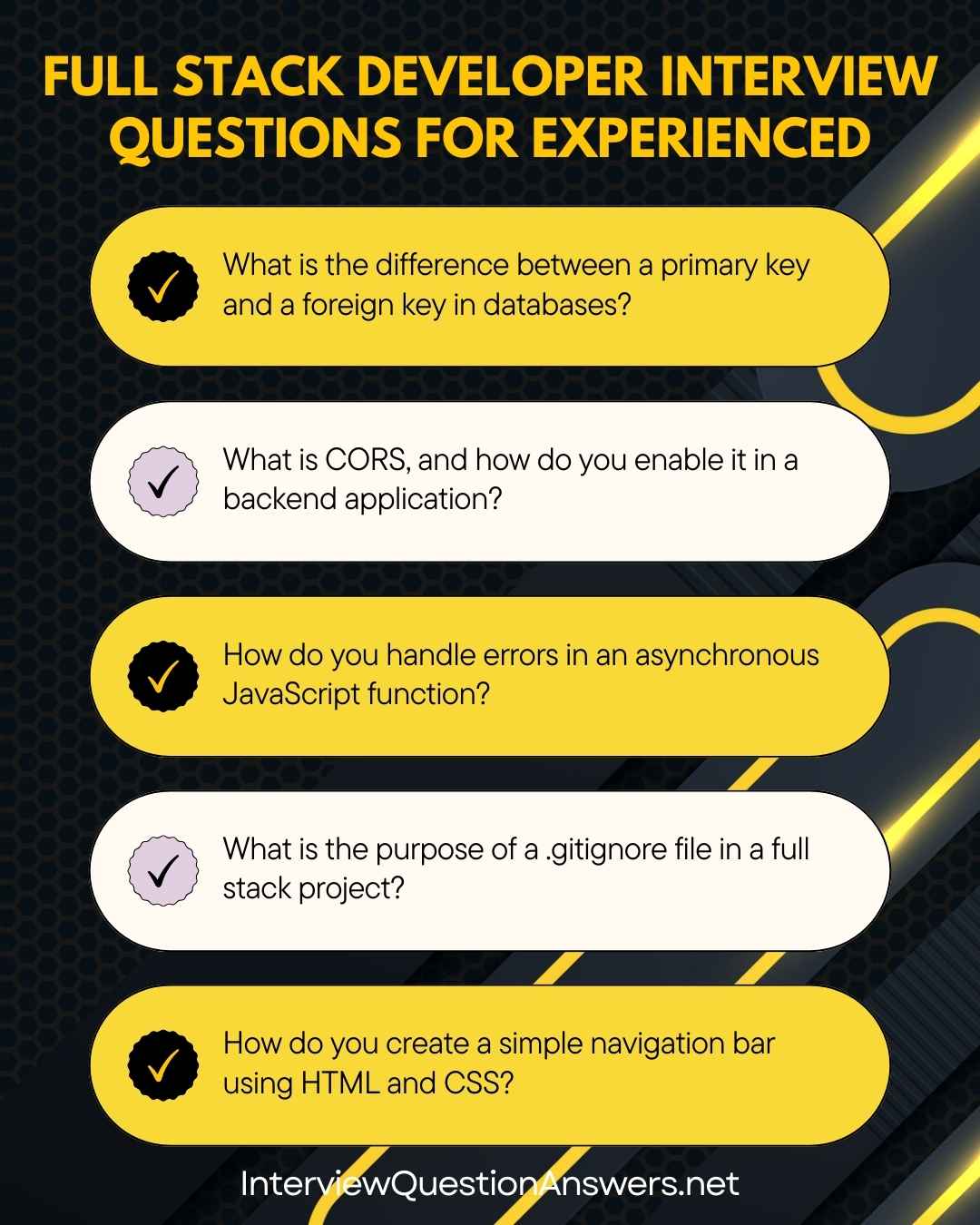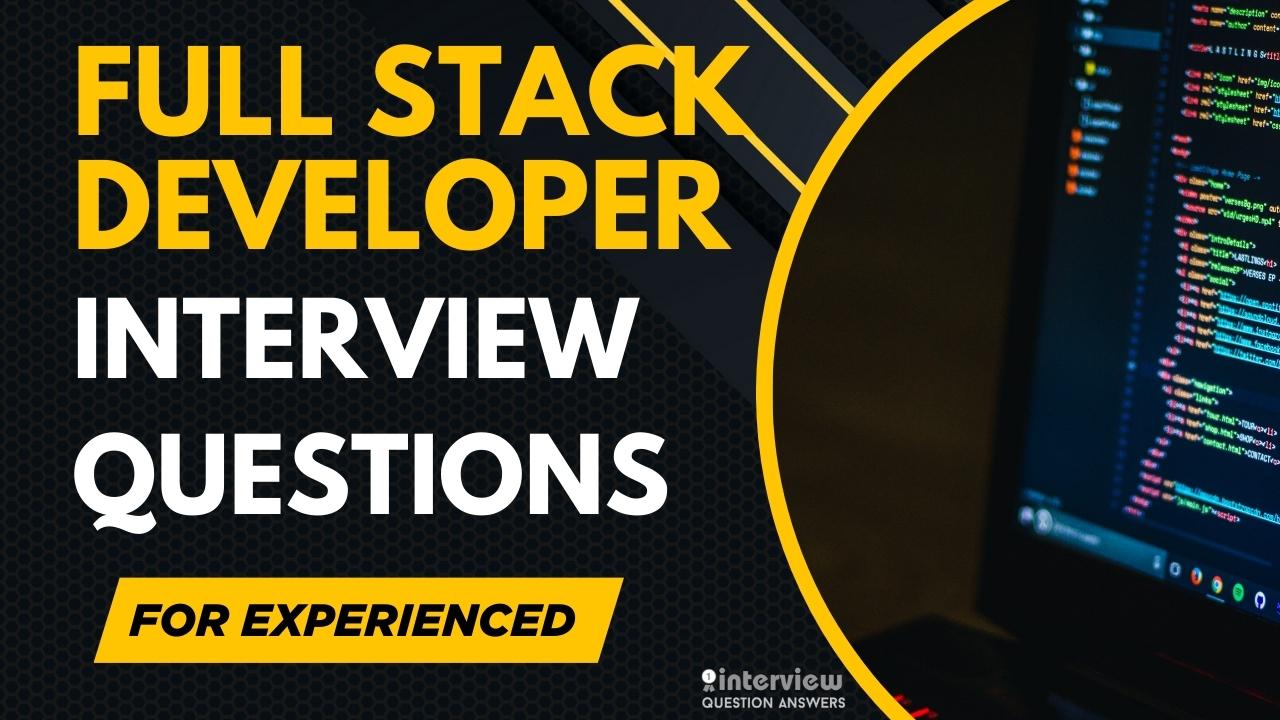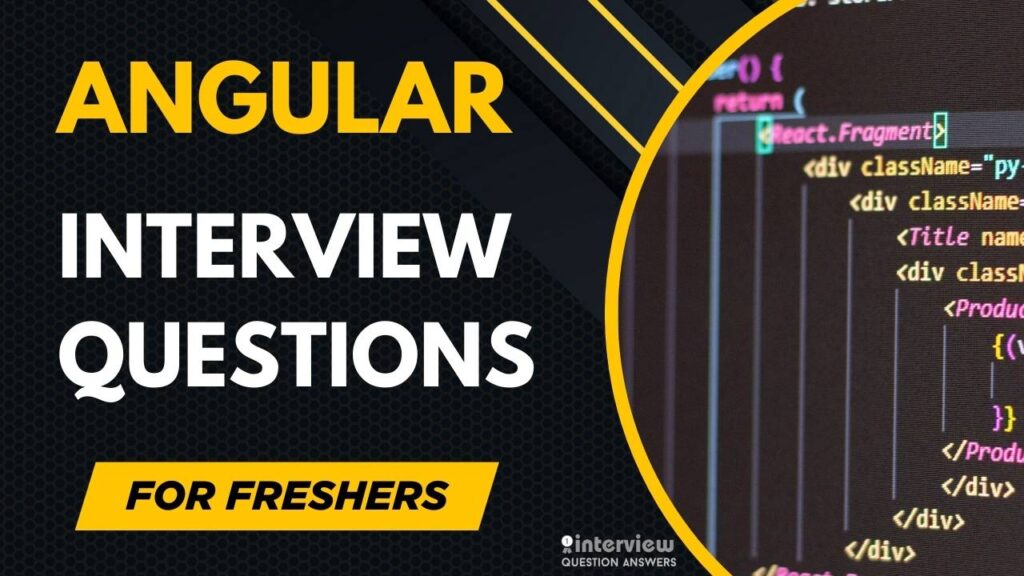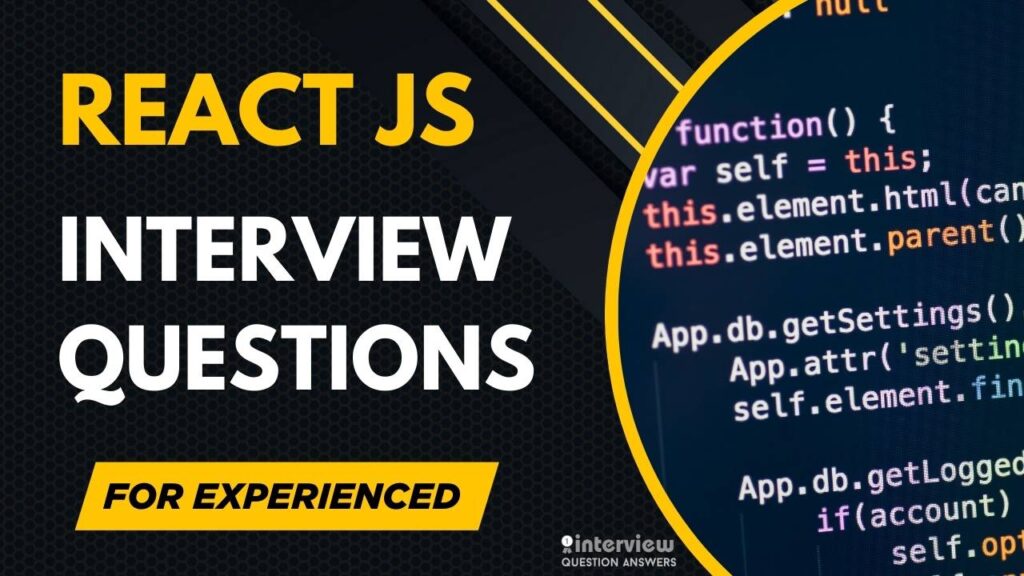Full Stack Developer Interview Questions for Experienced
Full Stack Developer Interview Questions for Experienced candidates evaluate comprehensive technical expertise, architectural design skills, and project leadership capabilities that seasoned professionals should display. Progressing to senior full stack roles requires demonstrating your experience in building scalable web applications and managing complete development cycles effectively.
This detailed interview guide features Full Stack Developer Interview Questions for Experienced developers who have delivered multiple production applications, covering advanced frontend frameworks, backend optimization techniques, DevOps integration, and team coordination responsibilities.
These Full Stack Developer Interview Questions for Experienced professionals will support you in presenting your technical breadth, sharing successful project outcomes, and proving your qualifications for senior full stack positions in competitive technology markets.
Table of Contents
Full Stack Developer Interview Questions for 2 Years Experience
Que 1. How do you handle state management in a React application?
Answer:
In React, state management for simple components uses useState. For more complex apps, useReducer handles logic-heavy state. Global state can be managed with Context API or libraries like Redux, ensuring efficient updates to avoid unnecessary re-renders.
import { useState } from 'react';
function Counter() {
const [count, setCount] = useState(0);
return <button onClick={() => setCount(count + 1)}>{count}</button>;
}Que 2. What is the difference between GET and POST HTTP methods?
Answer:
GET retrieves data from the server and is idempotent, sending parameters in the URL. POST submits data to the server, typically in the body, and is used for creating resources. GET is less secure for sensitive data as parameters are visible.
Que 3. How do you connect a Node.js backend to a MongoDB database?
Answer:
Use the mongoose library to connect and model data. Define a schema, connect with mongoose.connect(), and perform CRUD operations.
const mongoose = require('mongoose');
mongoose.connect('mongodb://localhost/mydb');
const User = mongoose.model('User', { name: String });
const user = new User({ name: 'John' });
user.save();Que 4. What is the purpose of middleware in Express.js?
Answer:
Middleware functions process requests in a pipeline, handling tasks like logging, authentication, or parsing. They run before route handlers and can modify requests or responses.
const express = require('express');
const app = express();
app.use((req, res, next) => {
console.log('Request received');
next();
});Que 5. How do you create a responsive layout using CSS Flexbox?
Answer:
Use display: flex on a container to align items flexibly. Properties like flex-direction, justify-content, and align-items control layout. Adjust with media queries for responsiveness.
.container {
display: flex;
flex-direction: row;
justify-content: space-between;
}
@media (max-width: 600px) {
.container { flex-direction: column; }
}Que 6. What is SQL injection, and how do you prevent it?
Answer:
SQL injection occurs when malicious input manipulates a query. Prevent it with prepared statements or parameterized queries to separate code from data.
# Using Python with SQLite
import sqlite3
conn = sqlite3.connect('database.db')
cursor = conn.cursor()
cursor.execute('SELECT * FROM users WHERE name = ?', (user_input,))Que 7. How do you fetch data from an API in JavaScript?
Answer:
Use the Fetch API or axios to make requests, handling responses with promises or async/await.
async function fetchData() {
try {
const response = await fetch('https://api.example.com/data');
const data = await response.json();
console.log(data);
} catch (error) {
console.error('Error:', error);
}
}Que 8. What is the difference between a primary key and a foreign key in databases?
Answer:
A primary key uniquely identifies records in a table (e.g., ID). A foreign key links to a primary key in another table, ensuring referential integrity.
CREATE TABLE users (
id INT PRIMARY KEY,
name VARCHAR(50)
);
CREATE TABLE orders (
order_id INT PRIMARY KEY,
user_id INT,
FOREIGN KEY (user_id) REFERENCES users(id)
);Que 9. How do you style a button in CSS?
Answer:
Use properties like background-color, padding, border, and :hover for effects.
button {
background-color: #007bff;
color: white;
padding: 10px 20px;
border: none;
cursor: pointer;
}
button:hover {
background-color: #0056b3;
}Que 10. What is CORS, and how do you enable it in a backend application?
Answer:
CORS (Cross-Origin Resource Sharing) allows restricted resources to be requested across domains. Enable it in the backend with headers or middleware.
// Express.js example
const express = require('express');
const app = express();
app.use((req, res, next) => {
res.header('Access-Control-Allow-Origin', '*');
next();
});Full Stack Developer Interview Questions for 3 Years Experience
Que 11. How do you create a simple form in HTML?
Answer:
Use the <form> tag with inputs and a submit button, specifying action and method.
<form action="/submit" method="POST">
<input type="text" name="name" placeholder="Name">
<button type="submit">Submit</button>
</form>Que 12. What is the purpose of the useEffect hook in React?
Answer:useEffect handles side effects like data fetching or DOM updates after render. It runs based on dependencies and can return a cleanup function.
import { useEffect } from 'react';
useEffect(() => {
console.log('Component mounted');
return () => console.log('Component unmounted');
}, []);Que 13. How do you write a basic SQL INSERT query?
Answer:
Use INSERT to add new records to a table, specifying columns and values.
INSERT INTO users (name, age) VALUES ('John', 25);Que 14. How do you add an event listener in JavaScript?
Answer:
Use addEventListener to attach a function to an event on an element.
document.getElementById('myButton').addEventListener('click', () => {
console.log('Button clicked');
});Que 15. What is the difference between flex and grid in CSS?
Answer:
Flexbox is for one-dimensional layouts (rows or columns). Grid is for two-dimensional layouts with rows and columns. Flexbox is simpler for alignment; Grid is powerful for complex structures.
.container {
display: grid;
grid-template-columns: 1fr 1fr;
}Que 16. How do you handle errors in an asynchronous JavaScript function?
Answer:
Use try-catch with async/await or .catch() with promises to manage errors.
async function fetchData() {
try {
const res = await fetch('/api/data');
return res.json();
} catch (error) {
console.error('Error:', error);
}
}Que 17. What is the purpose of a .gitignore file in a full stack project?
Answer:.gitignore specifies files or directories (e.g., node_modules, .env) to exclude from version control, preventing unnecessary commits.
node_modules/
.envQue 18. How do you center a div horizontally and vertically in CSS?
Answer:
Use Flexbox on the parent container with justify-content: center and align-items: center.
.parent {
display: flex;
justify-content: center;
align-items: center;
height: 100vh;
}Que 19. What is a primary key constraint in a database?
Answer:
A primary key uniquely identifies each record in a table, ensuring no duplicates. It’s often an auto-incrementing ID.
CREATE TABLE users (
id INT PRIMARY KEY AUTO_INCREMENT,
name VARCHAR(50)
);Que 20. How do you create a simple navigation bar using HTML and CSS?
Answer:
Use an unordered list (<ul>) for menu items, style with CSS for horizontal layout and hover effects.
<nav>
<ul>
<li><a href="/">Home</a></li>
<li><a href="/about">About</a></li>
</ul>
</nav>nav ul {
list-style: none;
display: flex;
}
nav li { margin-right: 10px; }
nav a:hover { color: blue; }
Also check: Full Stack Developer Interview Questions for Freshers
Full Stack Developer Interview Questions for 5 Years Experience
Que 21. How do you optimize a full stack application for performance across frontend and backend?
Answer:
On the frontend, use code splitting with React.lazy, lazy load images with loading="lazy", and minimize re-renders with useMemo. On the backend, cache API responses with Redis, optimize database queries with indexing, and use asynchronous processing. Monitor with tools like New Relic or Lighthouse.
// Frontend: React.lazy
const LazyComponent = React.lazy(() => import('./Component'));
function App() {
return <Suspense fallback={<div>Loading...</div>}><LazyComponent /></Suspense>;
}// Backend: Redis caching
const redis = require('redis');
const client = redis.createClient();
app.get('/api/data', async (req, res) => {
const cached = await client.get('data');
if (cached) return res.json(JSON.parse(cached));
const data = await db.query('SELECT * FROM data');
await client.setEx('data', 3600, JSON.stringify(data));
res.json(data);
});Que 22. How do you implement server-side rendering (SSR) in a React application with a Node.js backend?
Answer:
Use Next.js for SSR, rendering React components on the server with getServerSideProps. Configure a Node.js backend to handle API routes and serve pre-rendered HTML for better SEO and initial load performance.
// Next.js: pages/index.js
export async function getServerSideProps() {
const res = await fetch('http://backend:3000/api/data');
const data = await res.json();
return { props: { data } };
}
export default function Home({ data }) {
return <div>{data.map(item => <p>{item.name}</p>)}</div>;
}Que 23. How do you secure a full stack application against common vulnerabilities like XSS and CSRF?
Answer:
For XSS, sanitize inputs with DOMPurify on the frontend and avoid dangerouslySetInnerHTML. For CSRF, use tokens in forms, validated by backend middleware (e.g., csurf). Implement Content Security Policy (CSP) headers on the backend.
// Frontend: DOMPurify
import DOMPurify from 'dompurify';
const cleanInput = DOMPurify.sanitize(userInput);// Backend: Express CSRF
const csurf = require('csurf');
app.use(csurf());
app.post('/form', (req, res) => res.json({ message: 'Form submitted' }));Que 24. How do you implement JWT-based authentication in a full stack application?
Answer:
On the backend, generate JWTs with jsonwebtoken after login, storing tokens in HTTP-only cookies. On the frontend, include tokens in API requests and refresh them for session continuity.
// Backend: Express
const jwt = require('jsonwebtoken');
app.post('/login', (req, res) => {
const user = { id: 1, name: 'John' };
const token = jwt.sign(user, process.env.JWT_SECRET, { expiresIn: '1h' });
res.cookie('token', token, { httpOnly: true });
res.json({ message: 'Logged in' });
});// Frontend: Fetch with token
fetch('/api/protected', { headers: { Authorization: `Bearer ${token}` } });Que 25. How do you handle database migrations in a production full stack application?
Answer:
Use tools like Flyway or Sequelize to manage schema changes. Test migrations in a staging environment, backup data, and ensure frontend compatibility with updated APIs. Automate with CI/CD pipelines.
// Sequelize migration
module.exports = {
up: async (queryInterface, Sequelize) => {
await queryInterface.addColumn('users', 'email', Sequelize.STRING);
},
down: async (queryInterface) => {
await queryInterface.removeColumn('users', 'email');
}
};Que 26. How do you implement real-time features in a full stack application?
Answer:
Use WebSockets with socket.io for real-time updates. The backend pushes events to connected clients, and the frontend updates the UI dynamically. Ensure scalability with Redis pub/sub for high traffic.
// Backend: Socket.io
const io = require('socket.io')(server);
io.on('connection', (socket) => {
socket.on('message', (msg) => io.emit('message', msg));
});// Frontend: Socket.io client
import io from 'socket.io-client';
const socket = io('http://localhost:3000');
socket.on('message', (msg) => document.getElementById('chat').innerText += msg);Que 27. How do you optimize API response times in a full stack application?
Answer:
On the backend, cache with Redis, optimize queries with indexing, and use connection pooling. On the frontend, minimize requests, debounce inputs, and use CDNs for assets. Profile with tools like Chrome DevTools or New Relic.
// Backend: Redis caching
const redis = require('redis');
const client = redis.createClient();
app.get('/api/users', async (req, res) => {
const cached = await client.get('users');
if (cached) return res.json(JSON.parse(cached));
const users = await db.query('SELECT * FROM users');
await client.setEx('users', 3600, JSON.stringify(users));
res.json(users);
});Que 28. How do you implement pagination across frontend and backend?
Answer:
On the backend, use LIMIT and OFFSET in SQL or equivalent in NoSQL, returning metadata like total count. On the frontend, display paginated data with navigation controls.
// Backend: Express
app.get('/api/items', async (req, res) => {
const page = parseInt(req.query.page) || 1;
const limit = 10;
const offset = (page - 1) * limit;
const items = await db.query('SELECT * FROM items LIMIT $1 OFFSET $2', [limit, offset]);
res.json({ items, page, total: items.count });
});// Frontend: React
function Items({ page }) {
const [items, setItems] = useState([]);
useEffect(() => {
fetch(`/api/items?page=${page}`).then(res => res.json()).then(data => setItems(data.items));
}, [page]);
return items.map(item => <div>{item.name}</div>);
}Que 29. How do you ensure accessibility (a11y) in a full stack application?
Answer:
On the frontend, use semantic HTML, ARIA attributes, and test with screen readers like NVDA. On the backend, ensure APIs return structured data for accessibility tools. Use axe-core or eslint-plugin-jsx-a11y for compliance.
<!-- Frontend -->
<button aria-label="Toggle menu">☰</button>Full Stack Developer Interview Questions for 7 Years Experience
Que 30. How do you handle file uploads in a full stack application?
Answer:
On the frontend, use <input type="file"> with FormData. On the backend, process uploads with multer (Node.js) or boto3 (Python), storing in cloud storage like AWS S3.
<!-- Frontend -->
<input type="file" id="fileInput">
<script>
const file = document.getElementById('fileInput').files[0];
const formData = new FormData();
formData.append('file', file);
fetch('/upload', { method: 'POST', body: formData });
</script>// Backend: Express
const multer = require('multer');
const upload = multer({ dest: 'uploads/' });
app.post('/upload', upload.single('file'), (req, res) => res.json({ message: 'Uploaded' }));Que 31. How do you implement a responsive design with dynamic data from a backend?
Answer:
Use CSS Grid or Flexbox with media queries for responsiveness. Fetch dynamic data from the backend to populate UI components, ensuring layouts adapt to data changes.
.container {
display: grid;
grid-template-columns: repeat(auto-fit, minmax(200px, 1fr));
}// Frontend: React
function Grid() {
const [data, setData] = useState([]);
useEffect(() => {
fetch('/api/data').then(res => res.json()).then(setData);
}, []);
return <div className="container">{data.map(item => <div>{item.name}</div>)}</div>;
}Que 32. How do you test a full stack application for reliability?
Answer:
Use Jest and React Testing Library for frontend unit tests, pytest or Mocha for backend tests, and Cypress for end-to-end tests. Mock APIs with msw and automate with CI/CD pipelines like GitHub Actions.
// Frontend test
import { render, screen } from '@testing-library/react';
test('renders data', async () => {
render(<App />);
expect(await screen.findByText('Item')).toBeInTheDocument();
});Que 33. How do you implement rate limiting in a backend API?
Answer:
Use middleware like express-rate-limit with Redis to track requests per user/IP. Return 429 status for exceeded limits and inform the frontend to handle retries.
// Backend
const rateLimit = require('express-rate-limit');
app.use(rateLimit({ windowMs: 15 * 60 * 1000, max: 100 }));Que 34. How do you manage state across multiple components in a React application?
Answer:
Use Context API for simple global state or Redux Toolkit for complex state management. Optimize with memoized selectors to prevent unnecessary re-renders.
// Redux Toolkit
import { createSlice } from '@reduxjs/toolkit';
const userSlice = createSlice({
name: 'user',
initialState: { name: '' },
reducers: { setName: (state, action) => { state.name = action.payload; } }
});Que 35. How do you handle database connection pooling in a backend application?
Answer:
Use connection pooling (e.g., pg-pool for PostgreSQL) to reuse connections, reducing overhead. Configure pool size based on traffic and monitor for leaks.
const { Pool } = require('pg');
const pool = new Pool({ connectionString: process.env.DATABASE_URL, max: 20 });
pool.query('SELECT * FROM users', (err, res) => console.log(res.rows));Que 36. How do you implement logging in a full stack application?
Answer:
On the backend, use Winston or Python’s logging for structured logs. On the frontend, use Sentry for error tracking. Centralize logs with ELK Stack for analysis.
// Backend: Winston
const winston = require('winston');
const logger = winston.createLogger({
transports: [new winston.transports.File({ filename: 'app.log' })]
});
logger.info('API request');Que 37. How do you optimize a database for read-heavy workloads in a full stack application?
Answer:
Use read replicas for load distribution, cache queries with Redis, and index frequently queried columns. Ensure the frontend fetches only necessary data to reduce API load.
CREATE INDEX idx_user_email ON users(email);Que 38. How do you implement a GraphQL API in a full stack application?
Answer:
On the backend, use Apollo Server to define schemas and resolvers. On the frontend, use Apollo Client or urql to query data, leveraging caching for performance.
// Backend: Apollo Server
const { ApolloServer, gql } = require('apollo-server');
const typeDefs = gql`type Query { users: [User] } type User { id: ID, name: String }`;
const resolvers = { Query: { users: () => db.query('SELECT * FROM users') } };
const server = new ApolloServer({ typeDefs, resolvers });
server.listen();Que 39. How do you handle cross-service communication in a microservices-based full stack application?
Answer:
Use REST or gRPC for synchronous communication, or Kafka for event-driven async communication. On the frontend, aggregate data with API gateways like Apollo Federation.
// Backend: Kafka producer
const { Kafka } = require('kafkajs');
const kafka = new Kafka({ brokers: ['localhost:9092'] });
const producer = kafka.producer();
await producer.send({ topic: 'events', messages: [{ value: JSON.stringify({ id: 1 }) }] });Que 40. How do you ensure a full stack application is scalable?
Answer:
On the backend, use microservices with Kubernetes for horizontal scaling, load balancing with Nginx, and caching with Redis. On the frontend, use code splitting and lazy loading. Monitor with Prometheus and scale based on metrics.
# Kubernetes deployment
apiVersion: apps/v1
kind: Deployment
metadata:
name: app
spec:
replicas: 3
template:
spec:
containers:
- name: app
image: my-app:latestFull Stack Developer Interview Questions for 10 Years Experience
Que 41. How do you architect a full stack application to handle millions of concurrent users?
Answer:
Use a microservices architecture with Kubernetes for horizontal scaling, deploying services across regions with AWS Global Accelerator. Implement caching with Redis, use a CDN like Cloudflare for static assets, and optimize database queries with sharding (e.g., MongoDB) or read replicas. On the frontend, leverage code splitting, lazy loading, and WebSocket for real-time updates. Monitor with Prometheus and Grafana, ensuring fault tolerance with circuit breakers.
# Kubernetes deployment
apiVersion: apps/v1
kind: Deployment
metadata:
name: app-service
spec:
replicas: 10
template:
spec:
containers:
- name: app
image: my-app:latestQue 42. How do you ensure zero-downtime deployments in a high-traffic full stack application?
Answer:
Implement blue-green or canary deployments with Kubernetes, using rolling updates and health checks. Use feature flags (e.g., LaunchDarkly) for gradual rollouts, automate with ArgoCD, and cache assets in a CDN. Monitor with Datadog to detect issues, ensuring seamless frontend updates.
# ArgoCD canary rollout
apiVersion: argoproj.io/v1alpha1
kind: Rollout
spec:
strategy:
canary:
steps:
- setWeight: 20
- pause: { duration: 5m }Que 43. How do you implement real-time collaboration features in a full stack application?
Answer:
Use WebSockets with socket.io or GraphQL subscriptions for real-time updates. On the backend, leverage Redis pub/sub or Kafka for scalability. On the frontend, use libraries like Yjs for conflict-free data syncing (CRDTs). Ensure low latency with optimized payloads and monitor with Prometheus.
// Backend: Socket.io with Redis
const io = require('socket.io')(server, { adapter: require('socket.io-redis') });
io.on('connection', (socket) => {
socket.on('edit', (data) => io.emit('edit', data));
});Que 44. How do you secure a full stack application against advanced threats like DDoS and data breaches?
Answer:
Use AWS WAF or Cloudflare for DDoS protection, encrypt data with AES-256 (e.g., AWS KMS), and store secrets in HashiCorp Vault. Implement mTLS for backend services, enforce zero-trust with IAM roles, and audit with CloudTrail. On the frontend, sanitize inputs with DOMPurify and use CSP headers.
// Backend: Express with CSP
const helmet = require('helmet');
app.use(helmet.contentSecurityPolicy({
directives: { defaultSrc: ["'self'"], scriptSrc: ["'self'"] }
}));Que 45. How do you design a full stack application for multi-tenant architecture?
Answer:
On the backend, implement schema-based tenancy in PostgreSQL or namespace isolation in MongoDB, with RBAC for access control. Use an API gateway (e.g., Kong) to route tenant-specific requests. On the frontend, dynamically render tenant-specific UI with React Context. Monitor tenant metrics with Prometheus.
// Backend: Tenant middleware
app.use((req, res, next) => {
const tenantId = req.header('X-Tenant-ID');
req.db = connectToTenantDb(tenantId);
next();
});Que 46. How do you optimize a full stack application for low-latency database operations?
Answer:
On the backend, use in-memory caching with Redis, read replicas, and indexing. Optimize queries with EXPLAIN and batch operations. On the frontend, use Apollo Client caching or SWR for efficient data fetching. Profile with New Relic to identify bottlenecks.
CREATE INDEX idx_user_email ON users(email);// Frontend: SWR
import useSWR from 'swr';
function Data() {
const { data } = useSWR('/api/data', fetcher);
return <div>{data?.map(item => <p>{item.name}</p>)}</div>;
}Que 47. How do you implement observability in a distributed full stack application?
Answer:
Use Jaeger for distributed tracing, Prometheus for metrics, and ELK Stack for centralized logging. Implement correlation IDs across frontend and backend for request tracking. Visualize with Grafana and set up alerts for proactive monitoring.
// Backend: Correlation ID
app.use((req, res, next) => {
req.correlationId = require('crypto').randomUUID();
logger.info('Request', { correlationId: req.correlationId });
next();
});Que 48. How do you migrate a monolithic full stack application to microservices?
Answer:
Apply the Strangler pattern, extracting services by domain. Use Docker for containerization, Kubernetes for orchestration, and an API gateway for routing. On the frontend, incrementally refactor to micro-frontends with Module Federation. Test with chaos engineering tools like Chaos Mesh.
// Webpack Module Federation
module.exports = {
plugins: [
new ModuleFederationPlugin({
name: 'app',
exposes: { './Component': './src/Component' }
})
]
};Que 49. How do you implement a secure CI/CD pipeline for a full stack application?
Answer:
Use GitHub Actions or Jenkins, store secrets in AWS Secrets Manager, and enforce branch protection. Scan code with SonarQube, deploy with Terraform, and monitor with CloudWatch. On the frontend, use Webpack for optimized builds and test with Cypress.
# GitHub Actions
name: CI/CD
on: [push]
jobs:
deploy:
runs-on: ubuntu-latest
steps:
- uses: actions/checkout@v3
- run: npm run build
- run: terraform apply -auto-approve
env:
AWS_ACCESS_KEY_ID: ${{ secrets.AWS_ACCESS_KEY_ID }}Que 50. How do you design a full stack application for global scalability with low latency?
Answer:
Use a multi-region architecture with AWS Global Accelerator, deploy microservices with Kubernetes, and cache with Redis at edge locations. On the frontend, use Next.js for SSR and a CDN for static assets. Optimize API payloads and monitor latency with Datadog.
// Backend: Express with Redis
const redis = require('redis');
const client = redis.createClient({ host: 'edge.redis.com' });
app.get('/api/data', async (req, res) => {
const cached = await client.get('data');
if (cached) return res.json(JSON.parse(cached));
const data = await db.query('SELECT * FROM data');
await client.setEx('data', 3600, JSON.stringify(data));
res.json(data);
});Conclusion
The full stack development field evolves rapidly with headless architectures, serverless computing, and CI/CD pipelines becoming fundamental requirements for experienced positions. These Full Stack Developer Interview Questions for Experienced professionals offer the comprehensive preparation necessary for career progression, addressing everything from complex system integration to technical team management. By studying these Full Stack Developer Interview Questions for Experienced thoroughly and understanding contemporary full stack practices, you will be excellently positioned to obtain senior full stack developer opportunities.
Also Check:













